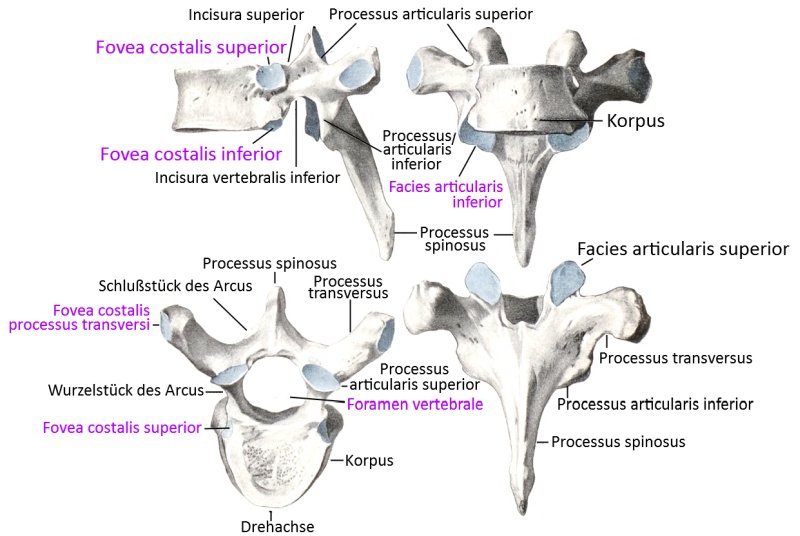Contents
Image: Thoracic vertebrae

Vertebra
For a detailed description of the vertebra, its joints and ligaments, see here.
Bone structures consisting of a vertebral body, vertebral arch and three processes: two transverse processes (processus transversus), to which muscles or ribs are attached, and a spinous process (processus spinosus), to which muscles are also attached. Together with the intervertebral discs (intervertebral discs, exception C1-C2), the vertebrae form the spinal column. The atlas (C1) and axis (C2) are an exception, as here the spine of the axis engages in the atlas instead of the vertebral arches and facet joints, thus allowing greater rotation in this segment. The vertebral bodies and the vertebral arch behind them enclose the round spinal canal, in which the spinal cord runs from the skull to approximately L1 and after its end the spinal nerves continue to run freely as the cauda equina. In addition to the false „joint“ that two vertebrae form with each other via the intervertebral disc between them, the vertebrae have a joint to the neighboring vertebra on the dorsal side, at the top and bottom, the facet joint.
Vertebra hole
The space between the vertebral arch (arcus vertebrae) and the vertebral body is known as the vertebral foramen. Together, the vertebral foramen form the spinalcanal, in which the spinal cord runs and from which the spinal nerves emerge.
Vertebral arch
The vertebral arch is a dorsally arranged, arched part of a vertebra that curves further dorsally towards the middle and forms the spinal canal (also known as the „spinal canal“) with the vertebral body, in which the spinal cord lies or, after its end in the L1 / L2 area, the cauda equina.
Vertebral body
The cylindrical part of the vertebra between the intervertebral discs is referred to as the vertebral body. The vertebral arches and the processes are not included.
Spinous process
the bony process protruding dorsally from the center of the vertebral arch of a vertebra; this is the attachment point for ligaments and muscles.
Transverse process
The bony process projecting laterally from each side of the vertebral arch of a vertebra. This is the attachment point for muscles, and in the thoracic spine also for ribs.
Costal process
Bone area lateral to the transverse process of the lumbar vertebrae. This is a remnant of a rib that has fused with the transverse process.
